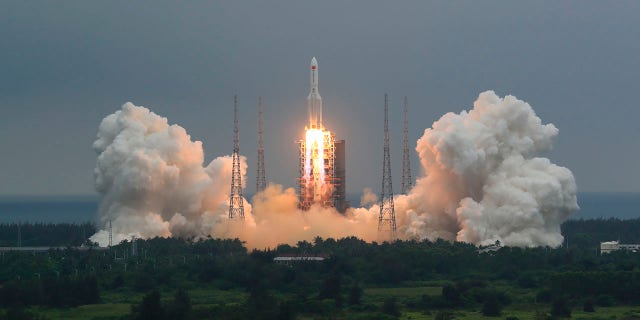Enormous Chinese rocket could crash back to Earth
FOX News’ Phil Keating reports pieces of the vessel that don’t burn in the atmosphere could splash down in the ocean or land in inhabited areas
An Italian astrophysicist has captured the almost 100-foot Chinese rocket core that is expected to make an uncontrolled re-entry into Earth’s atmosphere over the weekend.
Gianluca Masi, who runs the online Virtual Telescope Project, took a 0.5-second exposure photo of the fast-moving Long March 5B rocket from Italy using the “Elena” 17-inch Paramount robotic telescope.
WHAT HAPPENS WHEN SPACE DEBRIS CRASHES ON EARTH?
“At the imaging time, the rocket stage was at about 700 km from our telescope, while the sun was just a few degrees below the horizon, so the sky was incredibly bright: these conditions made the imaging quite extreme, but our robotic telescope succeeded in capturing this huge debris,” Masi wrote in a release.
In addition, he noted the “typical CCD blooming effect” — when shooting a bright light source that appears as a halo or line defect — due to the extreme brightness of the debris.
Masi said he would attempt to photograph the core again.
The image comes from a single, 0.5-second exposure, remotely taken with the "Elena" (PlaneWave 17″+Paramount ME+SBIG STL-6303E) robotic unit available at Virtual Telescope. The telescope tracked the exceptionally fast (0.3 deg/second) apparent motion of the object.
(Gianluca Masi, The Virtual Telescope)
While the core is expected to reenter the atmosphere as early as Saturday, exactly when and where remains unknown and will remain that way until just hours before impact.
Although the core will likely break apart and burn up in the upper atmosphere, U.S. Space Command is actively tracking its trajectory.
“The United States is committed to addressing the risks of growing congestion due to space debris and growing activity in space,” White House press secretary Jen Psaki told reporters on Wednesday. “We want to work with the international community to promote leadership and responsible space behaviors. It’s in the shared interests of all nations to act responsibly in space to ensure the safety, stability, security and long-term sustainability of outer space activities.”
CHINESE ROCKET DEBRIS TO MAKE AN UNCONTROLLED REENTRY: WHAT HAPPENED THE LAST TIME
Psaki added that if damage occurs from the debris — for which China could be held financially liable — the White House would consult with U.S. Space Command and the Department of Defense on how best to proceed.
Defense Secretary Lloyd Austin said Thursday that the U.S. has no plans to shoot down the core.
However, a spokesperson for China’s Foreign Ministry, Wang Wenbing, stated Friday that Chinese authorities would release information about the reentry of the rocket in a “timely manner.”
Wang said China “pays great attention to the re-entry of the upper stage of the rocket into the atmosphere.”
In this photo released by China’s Xinhua News Agency, a Long March 5B rocket carrying a module for a Chinese space station lifts off from the Wenchang Spacecraft Launch Site in Wenchang in southern China’s Hainan Province, Thursday, April 29, 2021. (Ju Zhenhua/Xinhua via AP)
“As far as I understand, this type of rocket adopts a special technical design, and the vast majority of the devices will be burnt up and destructed during the reentry process, which has a very low probability of causing harm to aviation activities and the ground,” he told attendees at a regularly scheduled media briefing.
For China, this isn’t the first time a situation like this has occurred.
Debris from another Long March 5B rocket rained down on at least two villages along Africa’s Ivory Coast last May.
While the pieces of the booster largely fell in the Atlantic Ocean (about 70% of the Earth’s surface is covered by water), coordinate updates from Space-Track.org — where the U.S. Space Command’s 18th Space Control Squadron offers daily updates — are all over the globe.
The site’s most recent tip posted to Twitter shows projected reentry on Sunday at “04:25(UTC) +/- 900 minutes at latitude -32.4 longitude 179.3.”
“NOTE: This is a huge, 30 hr window, and the time/location of re-entry will continue to vary wildly,” it wrote.
CLICK HERE TO GET THE FOX NEWS APP
The Aerospace Corporation — a nonprofit largely financed by the federal government, according to The New York Times — shows body reentry on Sunday at “03:53 UTC ± 11 hours,” though it admitted it was “still too early to determine a meaningful debris footprint.”
The Long March 5B was used to launch the core module of China’s first permanent space station on April 28.
Source: Read Full Article





